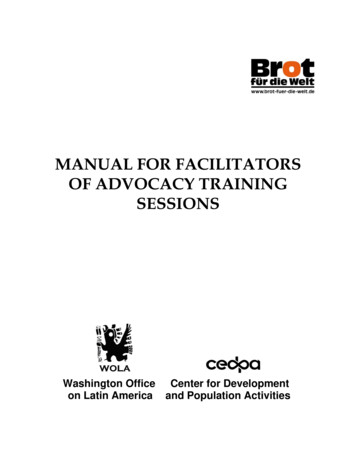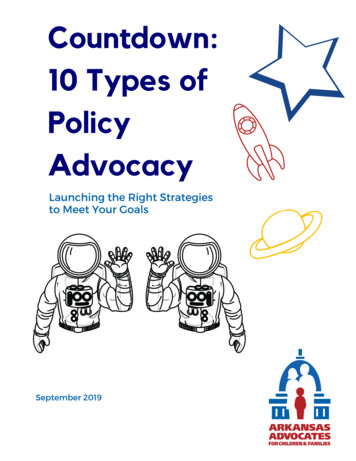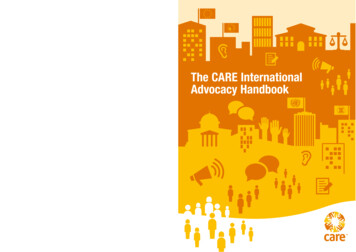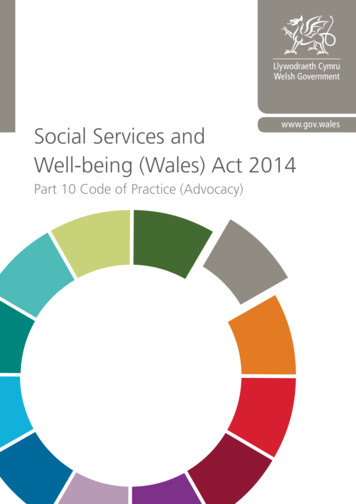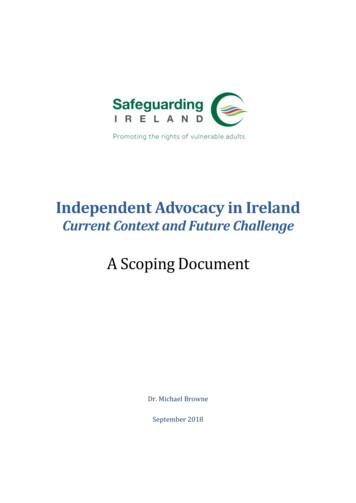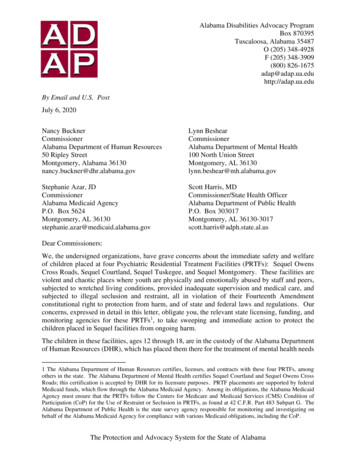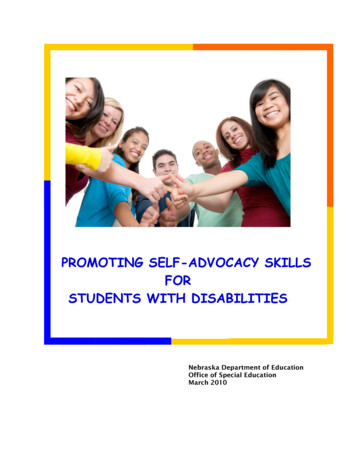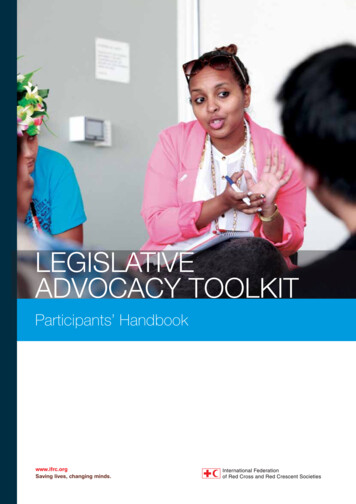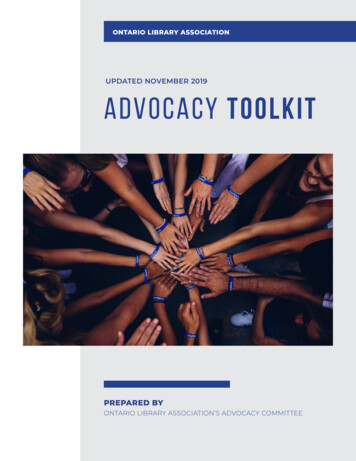
Transcription
communityadvocacy :a psychologist ’ s toolkit forstate and local advocacyDeveloped by Toolkit Taskforce Members:**Authors listed in alphabetical orderKira Hudson BanksSara BeachyAngela FergusonRobyn L. GobinIvy HoChristopher T. H. LiangKenneth I. MatonHaley A. Miles-McLeanRebecca L. Toporek
communityadvocacy :a psychologist’s toolkit forstate and local advocacyDeveloped by Toolkit Taskforce Members:**Authors listed in alphabetical orderKira Hudson BanksSara BeachyAngela FergusonRobyn L. GobinIvy HoChristopher T. H. LiangKenneth I. MatonHaley A. Miles-McLeanRebecca L. Toporek
TABLE OF CONTENTS5Commission6Acknowledgments7Preface8Brief Statement on Values9Definitions and Distinctions12Psychologists as Advocates15Psychologists’ Skills for Successful Advocacy18The Policy Arena20Getting Started in Advocacy23A Primer on Advocacy23 Focusing Effort28 Strategic Analysis30Policy Influence Methods32 Direct Advocacy Methods36 Direct or Indirect Advocacy Methods39 Indirect Advocacy Methods
44Institutional or Organizational Advocacy46Challenges to Advocacy Work and the Need for Self-Care47 Internal Challenges48 External Challenges49 How to Sustain51Ethical Considerations54Conclusion56References60Web Addresses for Hyperlinks62Additional Electronic Resources
COMMISSIONCommissioned by 2017 American Psychological Association (APA)CODAPAR Interdivisional Grant Awarded to:Division 17Society of Counseling Psychology (Arpana G. Inman,President, 2018)Division 27Society for Community Research and Action (YolandaSuarez-Balcazar, President, 2018)Division 35Society for the Psychology of Women (Margaret L.Signorella, President, 2018)Division 45Society for the Psychology Study of Culture, Ethnicityand Race (Helen Neville, President, 2018)5 COMMISSION
ACKNOWLEDGMENTSWe are grateful for the advocacy training session specifically arrangedfor us and led by Amalia Corby-Edwards of the American Psychological Association (APA) Public Interest Government Relations Office. Wealso appreciate the contributions of other APA staff members to thetraining session, our four divisional presidents, and the financial support provided by the CODAPAR Interdivisional Grant.ACKNOWLEDGMENTS6
PREFACEThis Advocacy Toolkit developed as a resultof a joint effort between four divisions ofthe American Psychological Association(APA): Division 17, the Society of CounselingPsychology; Division 27, the Society forCommunity Research and Action; Division35, the Society for the Psychology of Women; and Division 45, the Society for thePsychological Study of Culture, Ethnicityand Race. The goals were to develop ascience-based, high-quality advocacytoolkit that highlights different forms ofadvocacy strategies to inform policy at thestate and local levels and to build a community of grassroots psychologist advocates that can intervene to promotewell-being in the communities in whichthey reside.We understand that psychologists arecoming to this document with a range ofexperiences and knowledge. Our hope is toprovide a toolkit that facilitates the noviceand adds to the knowledge base of thosewho are seasoned. The purpose of thisdocument is to guide psychologists’ effortsto influence decision-makers as well asgovernmental, institutional, and organizational policies.We acknowledge other existing advocacytoolkits and would like our work to be seenin collaboration with this body of knowledge. We have learned from and built uponthe foundation made by these toolkits and7 PREFACEsee them as companions. Some focus solelyon federal advocacy1 for psychologists2;some highlight human-rights based3approaches and the importance of evaluation4; others focus on children5; others, still,focus on community6 based advocacy.These and other tools are importantresources for psychologists engaging inadvocacy. This current toolkit is distinctivein its focus on psychologists’ involvement instate and local advocacy and its coverage ofadvocacy across all branches (legislative,executive, judicial) of government.Numerous examples of psychologists areincluded, along with hyperlinks to provideaccess to more in-depth information and“how to” guides. For those with a printversion of this document, the web addresses (URLs) for the hyperlinks can be found inthe Web Addresses for Hyperlinks sectionnear the end of the toolkit.
BRIEF STATEMENT ON VALUESSeveral values guided this document. We believe in broad participation, collaboration, and culturally responsive advocacy -- we take intoconsideration the particular needs and circumstances of the groupswith whom we serve. Our stance is to work in partnership with communities rather than for or on behalf of them. We see psychologistsengaging in advocacy as acting in the public interest and acting inalignment with APA’s mission “to advance the creation, communication and application of psychological knowledge to benefit societyand improve people’s lives” (American Psychological Association[APA], 2019).BRIEF STATEMENT ON VALUES8
definitions anddistinctions
DEFINITIONS ANDDISTINCTIONSTerms related to advocacy often go undefined. Or, perhaps they are so often usedthat we are hesitant to admit we are notcertain about their meaning. In reality, someterms overlap or are used interchangeablywhen there are in fact distinctions. Sharedlanguage is an important first step in theprocess of advocacy, so we have attemptedto define and make distinctions betweensome common terms.There are several definitions of advocacy,which can be summarized as “action takento support a particular outcome or cause”(Toporek, Kwan, & Williams, 2012, p. 306).More specifically, Toporek and Liu (2001)described advocacy as a continuum rangingfrom empowerment to social actiondepending on the target of advocacy. Forexample, advocacy focused on a specificindividual may reflect individually focusedinterventions aimed toward client empowerment (e.g., in a clinical situation), and atthe macro level advocacy aimed at largersystems may reflect social action. Empowerment could also take place at a group orcommunity level, such as working withcommunities in capacity building. Specificto psychology, advocacy refers to promoting the application of psychological knowledge to inform policy (APA, 2014). When wethink about “policy”, laws often come tomind. However, policy can also refer to10 COMMUNITY ADVOCACYgovernmental rules and regulations as wellas accepted practices and norms within anorganization or institution.At times, advocacy has been conflated withactivism, because the behaviors that individuals engage in can overlap. While similar,advocacy can involve either an internalpathway of influence through direct contact with decision-makers, or an externalpathway of influence through contact withothers who influence decision-makers.Alternatively, activism typically involves anexternal pathway of influence and relies ontechniques of pressure and persuasion tochallenge oppression and push for change.Watts and colleagues (2003) have offereda simple definition of activism, namely,doing something about oppression. Advocacy often occurs within a system with theassumption that with enough sharing ofinformation the system will respond effectively. On the other hand, activism is morelikely to indict the system and take anapproach that recognizes the rigid nature ofoppression. From a societal level, advocacyand activism can be in alignment with thegoal of social justice. Social justice has thegoal of promoting “a common humanity ofall social groups by valuing diversity andchallenging injustice and disparities in all itsforms” (e.g., health, educational, economic,and political inequities; Leong, Pickrens &Vasquez, 2017, p. 779). Advocacy can bepursued by any individual, and trainingexists to increase the effectiveness ofadvocacy in creating social change.
Although advocacy and activism can happen in a variety of settings and be directedat various targets, lobbying is a form ofadvocacy that often occurs within thecontext of legislation and executive branchdecision-making. Lobbying is directed atinfluencing governmental officials to vote acertain way or take a specific course ofaction and is conducted by registeredlobbyists. Guidelines and policies regardinglobbying often vary from state to statedepending on the arena in which one islobbying. Another distinction is that whilelobbying targets governmental laws, regulations, and services that enhance the wellbeing of citizens, advocacy and activism canalso target institutional or organizationalpolicy, which refer to what institutional ororganizational leaders expect their members to do (Maton, 2017). These distinctionscan be helpful as individuals make sense ofwho is the target of advocacy and thedifferent dynamics that are at play in therealm of seeking social justice.DEFINITIONS AND DISTINCTIONS11
psychologistsas advocates
PSYCHOLOGISTS ASADVOCATESPsychology, as the study of the mind andbehavior, has great potential to “benefitsociety and improve lives” (APA, 2019).Psychologists have expertise regarding theeffects of societal and systemic oppressionon individuals, families, communities, andlarger systems given their experience aspractitioners and researchers. Scholarlyexpertise and “on the ground” experienceengender understanding related to topicssuch as immigration and deportation,incarceration, violence, institutional racismand implicit bias, education, poverty, mentalhealth, and health disparities, allowingpsychologists to make important contributions to inform the public anddecision-makers. Advocacy provides a clearprofessional avenue for both practitionersand researchers to address the issues thataffect communities and society by sharingtheir expertise as well as amplifying voicesof communities not always heard in policydiscussions. The people with whom psychologists work are affected by governmentand organizational policies and practices,and the ability of psychologists to conductand use their research for the bettermentof society and to serve individuals andcommunities is impacted by policies andpractices of media, organizations, andgovernments. Further, psychologists cancontribute much to important socialchange work being done by other13 COMMUNITY ADVOCACYdisciplines and advocacy groups whetherthrough coalitions or in a consultative role.It is imperative that psychologists’ knowledge and voices inform social and institutional policies, despite challenges and risksinvolved in advocacy work as discussedlater in this toolkit.There are numerous examples of theimportant contributions psychologists havemade to the betterment of society throughadvocacy. At the national level, theseinclude advocacy efforts that resulted ininfluential national legislation, executivebranch rules and regulations, andprecedent-setting Supreme Court decisions. Sometimes the contributions ofpsychologists are in the forefront of anadvocacy effort and other times psychological research and perspective add to acumulative effort of many disciplines. Theexamples below provide a glimpse of thecontributions a few psychologists havemade in successful advocacy, influencingimportant national legislative, executivebranch, and judicial policies (for moreexamples, see Maton, 2017). Testimony and research of Mamie andKenneth Clark influencing Brown v. theBoard of Education (1954) Development of Head Start and relatedearly childhood initiatives (UrieBronfenbrenner and Edward Zigler;Zigler & Styfco, 2010) Housing First Initiative, an executivebranch policy addressing the issue ofhomelessness advocated by SamTsemberis and Marybeth Shinn. (Maton,
2017, pp. 182-185) Maternal, Infant, and Early ChildhoodHome Visiting Bill (David Olds; Maton,2017, pp. 64-68) Expert testimony (Greg Herek; Maton,2017, pp. 89-90) focused on overturningCalifornia’s ban on gay marriage Expert witness testimony regarding biasin employment assessment (JanetHelms; pp. 11-127) Expert witness testimony regardingdiscrimination against women in theworkplace (Susan Fiske; Maton, 2017, pp.86-89).At the state and local levels, psychologistshave also been engaged in many importantefforts ongoing over decades. These effortsmay not be as visible as national legislation,executive branch programming or judicialdecisions yet they have had importantimpacts on the well-being of individuals,families and communities. Examplesinclude:New York City (Hiro Yoshikawa; Maton,2017, pp. 201-203) Contributing to a community organizingeffort that generated substantial fundingin Camden, New Jersey to addressvacant housing (Paul Speer; Maton,2017, pp. 83-84).Important advocacy efforts over the yearshave also occurred within the profession,including the removal of homosexuality as adisorder in the DSM-III (Evelyn Hooker;Floyd & Szymanski, 2007), and more recently reversing APA’s policies and ethical standards regarding the role of psychologists inperforming interrogations (multiple psychologists). There are countless other localexamples, too numerous to name. Of note,8 of 29 psychologists honored by APA in2018 as exemplary citizen-psychologistswere involved in local advocacy efforts(DeAngelis, 2018). Our hope is that thistoolkit can assist even more psychologiststo envision and put their expertise intoaction. Leading a statewide effort in Connecticut to divert status offenders (non-criminal offenses such as running away fromhome or being truant from school) fromthe juvenile justice system (PrestonBrittner; Maton, 2017, pp. 68-70), Preserving affirmative action at theUniversity of Michigan (Nancy Cantor,Patricia Gurin; Maton, 2017, pp. 197-198,250-252), Contributing to innovative programmingfor undocumented immigrant families inPSYCHOLOGISTS AS ADVOCATES14
psychologists ’skills forsuccessfuladvocacy
PSYCHOLOGISTS’SKILLS FORSUCCESSFULADVOCACY.Psychologists bring to bear multiple sets ofskills shown to be important for successfuladvocacy (Maton, 2017). Relationship building skills. From working with one’s graduate school advisorand committee members, to negotiatingone’s first professional position, tointeracting with strangers at a conference, many psychologists have the skillsto navigate a variety of interpersonalsituations. These skills are helpful in alldomains of the policy arena, includingdevelopment of trusting working relationships with policymakers and theirstaff. Such relationships typically arebuilt upon mutuality, including thewillingness to provide informationor other resources of value in a timelymanner to policymakers, as well asan understanding of confidentialitysurrounding sensitive information. Communication skills. Psychologists arefrequently teaching others, even whenwe do not realize it. Teaching oftenoccurs outside of the traditional classroom. Sometimes, we are explaining ourcurrent research project to a relative at afamily dinner; other times, we are sharing our area of expertise with a new16 COMMUNITY ADVOCACYacquaintance at a conference. Psychologists who have experience and/ortraining working in applied or non-academic settings are already skilled in thetask of translating complex researchfindings into a user-friendly and conciseformat with clear, jargon-free language.These skills will be important when weengage in advocacy via direct communication, such as face-to-face meetingswith stakeholders or policymakers. Inaddition to oral communication, psychologists are trained to have strongwritten communication skills. Theseskills are essential when writing policyreports and recommendations or mediapieces for broad audiences. Our oral andwritten communication skills are applicable to advocacy work with communitymembers, coalition partners, legislators,executive branch officials, and in thejudicial context. It is also important forus to be flexible in adjusting the way ourideas are communicated and presenteddepending on the audience, their priorities, and their perspectives. Strategic analysis skills. Strategic analysisencompasses both policy analysis andstrategy development (Maton, 2017).Psychologists are able to criticallyevaluate social problems, generatepotential solutions, and formulate a planof action to achieve a policy goal. Policyanalysis may include the generation ofnovel policy approaches for a givensocial issue, contrasting benefits andlimitations of differing approaches, andexploring both systemic and unintended
consequences of proposed policyapproaches. Strategy developmentincludes identifying the policymakerwho needs to be targeted to effectchange, and the pathways throughwhich we can share our findings,perspectives, and expertise with thatindividual or group. Our capacity andtraining in complex strategy development to influence outcomes will provehelpful in this regard. More generally,many psychologists are trained in anecological model (e.g., consideringindividual and systemic factors), whichincorporates multiple levels of analysis,a useful framework for understandingcomplex policy issues and working inthe policy realm.Therefore, you reach out to this personwith your idea and try to persuade themto support your cause (hypothesistesting). Based on the legislator’sresponse (collecting data), you gaugewhether they are, indeed, an ally to yourcause (interpreting the data) and decideon the next steps (developing futuredirections). Research skills. Policy can be influencedby various types of research, includingevaluation research, applied theorybased research, and systems-focusedresearch. These skills allow us to generate policy-relevant findings, and tosynthesize and translate findings tocontribute to policy change. Ourresearch skills also help us to critiquethe quality of research that may be usedto support the efforts of those workingin opposition to our policy goals. From adifferent perspective, research skills canbe applied in novel ways for the purposeof doing policy advocacy. For example,you review a legislator’s record (this isakin to conducting a literature review),and you gather that this legislator isamenable to your cause and would bea good ally (formulating a hypothesis).PSYCHOLOGISTS’ SKILLS FOR SUCCESSFUL ADVOCACY17
the policyarena
THE POLICY ARENAThe policymaking process is highly complex—comprising multiple phases, levels,policy players, and sources of influence(Maton, 2017). The four primary phases ofthe policy cycle are agenda setting (e.g.,determining what policies will be addressedduring a legislative session), policy formulation and adoption (e.g., writing and passinglegislation), policy implementation (e.g., theprocess of applying/carrying out passedlegislation), and policy evaluation andrevision (e.g., reviewing the efficacy of thelegislation in addressing the targeted policyissue and altering the legislation or implementation as needed). These phases areinteractive and iterative, and this dynamicand cyclical nature plays out at interrelatedlocal, state, and national levels. Policyplayers (stakeholders) include officials in thelegislative, executive, and judicial branchesof government, advocacy and intermediary(e.g., professional and advocacy) organizations, researchers, citizens, health careorganizations and institutions, and themedia (including social media). Sources ofinfluence on policymakers include politics,events, values, evidence, expertise, capacity,ideology, interests, relationships, networks,and existing social problems and availablesolutions. Psychologists can and haveexerted important policy influence in allphases and levels of the policy process,from multiple vantage points and policyplayer roles, while also drawing on multiplesources of influence.19 COMMUNITY ADVOCACY
gettingstarted inadvocacy
GETTING STARTEDIN ADVOCACYThose who are not yet involved in advocacywork, including graduate students and earlycareer psychologists, may wonder how theycan become involved. Here are practicalsuggestions for entering and engaging withthe policy world:Participate in the policy committee of yourprofessional society (e.g., division of APA,State Psychological Association). Manypolicy committees actively seek out anddesire the help of graduate students interested in both general policy work andspecific policy initiatives. Additionally, manyState Psychological Associations haveadvocacy days where they teach individualshow to speak with state legislators. APA alsohas multiple committees for students (e.g.,Science Student Council) where studentsmay gain experience advocating on behalfof social scientists at the federal and organizational level. For examples of APA’sstudent groups follow the links below:Science Student Council8APA Campus Ambassador9State Psychological Association chapter10Volunteer for or join a policy-orientedorganization (e.g., advocacy organization)related to your research or personal experience. Individuals may also find student-run21 COMMUNITY ADVOCACYadvocacy groups on their campuses (e.g.,graduate student councils, LGBTQIA andally groups). Furthermore, many universitiespartner with non-governmental organizations (NGOs) and other advocacy groups intheir respective communities. Students maywant to seek out these groups as communication and infrastructure for advocacy arealready established within theseorganizations.Seek out faculty, university research andpolicy institutes or centers, and practitioners actively involved in policy work, andask about ways to get involved in specificpolicy-relevant projects.Apply for APA, The Society for the Psychological Study of Social Issues (SPSSI), orSociety for Research in Child Development(SRCD) Congressional fellowship programs,or policy internships in your specific area ofinterest.Learn to ask policy-relevant questionsthrough exposure to: Policy-relevant coursework inpsychology and other disciplines Ecological and systemic theories The policy focus and related products(i.e. briefs and reports) of advocacyorganizations and policymakers in yourarea(s) of interest.Invite input from policy-informed facultyand/or policy practitioners on how toincrease the policy relevance of yourresearch projects (e.g., master’s thesis,
dissertation, grant proposals) early in theplanning process.Gain experience working in the settingsand with the populations you hope tocollaborate with, to understand first-handthe contextual realities that policy mustconsider and the real-life impacts of policy.This includes volunteering to serve invarious capacities (e.g., as youth mentor,board member) in organizations that servethe populations that you want to workalongside. Reading local newspapers thatreport about issues that are morerelevant to your specific community.Consider engaging in your student body.Most graduate programs have studentcouncils where individuals can volunteer orrun to be a representative in the studentsenate body. Individuals can also try toorganize other grassroots movements suchas on-campus postcard drives or voterregistration.Become knowledgeable on legislativeprocesses and decision-makers. This advocacy toolkit is one starting point. You mayalso want to consider these followingsuggestions: Identify your state11 and federal12legislators. Stay informed about local legislation by: Attending city council or town hallmeetings Attending events where your localofficial will make an appearance Subscribing to local legislators’newslettersGETTING STARTED IN ADVOCACY 22
a primer onadvocacy23Focusing Effort28Strategic Analysis
A PRIMER ONADVOCACYImportant steps for advocacy can begrouped into two processes: (1) focusingeffort and (2) strategic analysis. Focusingefforts entails identifying issues, advocacytarget, level of advocacy, and type ofinvolvement. Strategic analysis includesdeveloping goals, identifying stakeholders,allies, and opponents, identifying decision-makers and relevant committees,and choosing a policy influence method.and with whom to develop partnerships.Although clarifying values is an importantinitial step, this should be an on-goingprocess.Things to consider: Create group agreement or mission Post agreement on mission in publicspaces, including social media Reiterate values at regular advocacymeetingsFocusing EffortIDENTIFY PROBLEMS ANDISSUES OF INTERESTIdentifying a clear and specific problem andan actionable issue (i.e., possible solution toat least one aspect of that problem) is oneof the first and most critical aspects ofengaging in advocacy work. Some psychologists will have an area of existing clinicaland/or research expertise within which theyare interested in engaging in advocacy (i.e.,problem area of general focus such aspoverty); the challenge for them may befinding a specific policy “issue” within thatlarger area of expertise on which to focus(e.g., a researcher who focuses on povertycould advocate about the importance of theSupplemental Nutrition Assistance Program,formerly known as food stamps).CLARIFYING VALUESClarification of values is important whenengaging in advocacy as values drive stakeholder accountability and keep individualsaligned towards the same goals and solutions. Clarification of values also helpsindividuals and groups decide whetherAdvocacy can also involve identifying theroot of a social problem, which may resolvemany of the related negative symptoms oroutcomes. As an example, health careprofessionals, including psychologists, inthe 1990’s saw a problem with mentalillness, mental health stigma, as well asHere, as an example, we outline steps toconsider taking when engaging in legislativeadvocacy (Figure 1), which is best pursuedwhen there is a clear set of strategies andgoals. Although these steps are not meantto be prescriptive in their ordering, use ofthis approach can be helpful in organizinglegislative advocacy efforts at the federal,state, or local level, and for non-legislativeadvocacy as well. First, and throughout theadvocacy process, it is important to clarifyvalues.24 COMMUNITY ADVOCACY
START HERE!Clarify ValuesResearch theProblem andIssues(e.g., whatindividuals/groups andinvolved)Decide onAdvocacyLevel(i.e.federal orConsiderResearchand/orClinicalInterestsIdentify Problemsand Issues of InterestDecide onType llies, andOpponentsor group )state or local )Develop Long/Short TermSMART GoalsFocus onSustainabilityDecide onAdvocacyTarget(i.e.judiciallegislativeexecutive )Choose Policy Influence MethodDirect InfluenceIndirect InfluenceID DecisionMakers andRelevantCommitteesDoResearchon DecisionMakersFIGURE 1.FOCUSINGEFFORTENGAGE IN SELF-CARE AND BE MINDFUL OFETHICAL AND MULTICULTURAL CONSIDERATIONSSTRATEGICANALYSISA PRIMER ON ADVOCACY 25
people’s lack of access to mental healthservices within their communities. With thelack of clear Federal legislation (until the2000s), advocates addressed this problemby tackling the actionable issue of mentalhealth parity to ensure coverage for mentalhealth problems.Things to consider: Without a clear understanding andidentification of the problem, advocacyefforts may merely address thesymptoms. When asking communities to discusssome of the problems they experience,the responses may sometimes benumerous negative symptoms of asingle root problem. Deciding on the specific actionable“issue” will depend in part on what iscurrently on the minds of policymakersand community members (i.e., is there a“policy window” open to take advantageof at the moment) Deciding on the specific “issue” willdepend on the feasibility of relevantsolutions related to that issueRESEARCH THE PROBLEM AND ISSUESResearch regarding previous and currentadvocacy efforts is important as it candetermine previous successes/failures andhelp to clarify whether this is the right timeto pursue the action. In this process it isimportant to be mindful of unintendedconsequences of engaging in advocacy.26 COMMUNITY ADVOCACYThings to consider: Whether this is a priority of thecommunity Budget and resources Priorities of any funders and donors Length of time required for advocacyplan (e.g., years vs. days) Feasibility of influencingdecision-makers Timing of advocacy efforts Whether others are (have been) workingto address the issue Whether the identified problem is asymptom of a larger oneDECIDE ON ADVOCACY LEVELIndividuals should consider advocacy at thefederal, state, or local level. Although muchattention is placed at the federal level, wefocus attention here on targeting advocacyefforts at the State and Local level as oneway of influencing law and policy.Things to consider: State governments typically follow asimilar structure as the Federal government. That is, State governments arecomprised of executive (e.g., governor),legislative (e.g., assembly, senate), andjudicial branches (e.g., courts). State legislative processes follow a clearprocess with many avenues for advocacy. Each step in the process can be a sitefor action. Although processes for billsto become law may vary state by state,the typical path follows similar steps. An
example of state-level legislative processes can be found by clicking here13. Local governments (e.g., city, town,townships, boroughs, etc.) are comprised of an executive (e.g., mayor,president, directors of health andhuman services) and council members.Click here14 for more information onlocal government processes. School superintendents and schoolboard members also are critical decision-makers that exert influence onlocal matters. Knowledge of “informal” power structures (e.g., networks in the business/corporate, non-profit, or philanthropicsectors) and relationship-building withthese individuals may also help advocacy for marginalized individuals at thecommunity-level (e.g., including unincorporated communities with littleformal government, other institutions).Organizational policy also may be atarget for advocacy efforts.DECIDE ON ADVOCACY TARGETOnce an individual decides to engage inadvocacy to address the identified issue,they may choose to focus their efforts ona target (i.e., judicial, legisl
contribute much to important social change work being done by other disciplines and advocacy groups whether through coalitions or in a consultative role. It is imperative that psychologists' knowl-edge and voices inform social and institu-tional policies, despite challenges and risks involved in advocacy work as discussed later in this toolkit.
